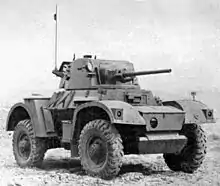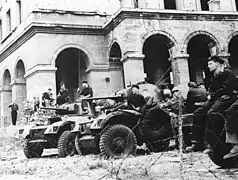| Daimler Armoured Car | |
|---|---|
 Daimler Armoured Car Mk II | |
| Type | Armoured car |
| Place of origin | United Kingdom |
| Production history | |
| Manufacturer | Daimler |
| No. built | 2,694 |
| Specifications | |
| Mass | 7.6 t |
| Length | 13 feet 1 inch (4 m) |
| Width | 8 feet 1 inch (2.46 m) |
| Height | 7 feet 5 inches (2.26 m) |
| Crew | 3 |
| Armour | 7–16 mm |
Main armament | 2 pounder QF 52 rounds |
Secondary armament |
|
| Engine | Daimler 27 4.1 litre 6-cylinder petrol 95 hp (71 kW) |
| Power/weight | 12.5 hp/tonne |
| Transmission | 5 speed (both directions) with fluid flywheel |
| Suspension | 4 × 4 wheel, independent coil spring |
Operational range | 200 miles (320 km) |
| Maximum speed | 50 miles per hour (80 km/h) |
The Daimler Armoured Car was a successful British armoured car design of the Second World War that continued in service into the 1950s. It was designed for armed reconnaissance and liaison purposes. During the postwar era, it doubled as an internal security vehicle in a number of countries.
Former British Daimler armoured cars were exported to various Commonwealth of Nations member states throughout the 1950s and 1960s. In 2012, some were still being operated by the Qatari Army.[1]
Design and development

The Daimler Armoured Car was a parallel development to the Daimler Dingo "Scout car", a small armoured vehicle for scouting and liaison roles. It was another Birmingham Small Arms design. A larger version designed on the same layout as the Dingo fitted with the turret similar to that of the Mark VII Light Tank and a more powerful engine.[2] Like the scout car, it incorporated some of the most advanced design concepts of the time and is considered one of the best British AFVs of the Second World War. The 95 hp engine was at the rear linked through a fluid flywheel to a Wilson preselector gearbox and then a H-drive arrangement with propshafts to each wheel. Four wheel steering similar to early models of the Scout car was considered but not implemented following experience with the Dingo.
The prototypes had been produced in 1939, but problems with the transmission caused by the weight of the vehicle delayed service entry until mid-1941. Daimler Company built 2,694 armoured cars.
The Daimler had full independent suspension and four wheel drive. Epicyclic gearing in the wheel hubs enabled a very low ratio in bottom gear – it was credited with managing 1:2 inclines. The rugged nature combined with reliability made it ideal for reconnaissance and escort work.
The variant of the turret and the 2pdr gun were also used on the Light Tank Mk VII Tetrarch.
Combat history

The Daimler saw action in North Africa with the 11th Hussars and the Derbyshire Yeomanry. It was also used in Europe and a few vehicles reached the South-East Asia theatre. A typical late war recce troop in north-west Europe would have two Daimler Armoured Cars and two Daimler Dingo scout cars.
A British Indian Army armoured car regiment, the 16th Light Cavalry, which formed part of Fourteenth Army troops was partly equipped with Daimlers and served in the reconquest of Burma.[3][4]
To improve the gun performance, some Daimlers in the European Theatre had their 2-pounders fitted with the Littlejohn adaptor, which worked on the squeeze bore principle. This increased the gun's theoretical armour penetration and would allow it to penetrate the side or rear armour of some German tanks.[5]
Daimlers were used by the territorial units of the British Army until the 1960s, outlasting their planned replacement, the Coventry Armoured Car. It was still being used, along with Daimler Dingoes, by B Squadron, 11th Hussars in Northern Ireland as late as January 1960.
An Indian Army regiment, 63 Cavalry, was raised with Humber Armoured Cars in one of its squadrons. This squadron was later hived off as an independent reconnaissance squadron and the integral squadron re-raised with Daimlers.[6] In the early sixties, Humbers and Daimlers of the Indian Army formed the mounts of the President's Bodyguard and were deployed in the defense of Chushul during the 1962 Sino-Indian War.[7][8]

The Ceylon Army received twelve Daimlers in 1959 with the establishment of its 1st Reconnaissance Regiment. The Daimlers served with the Sri Lanka Armoured Corps till the late 1990s having served with the 1st Reconnaissance Regiment in the 1971 JVP insurrection and early part of the Sri Lankan Civil War most notably during the First Battle of Elephant Pass in which at lest one Daimler was knocked out.[9]
Conflicts
Variants
- Mark I
- Mark I CS – close support version with 76 mm gun.
- Mark II – improved turret, modified gun mount, improved radiator, driver escape hatch incorporated into roof, WP grenade container fitted in turret and smoke generator container modified.[10]
- A turretless regimental command version, known as SOD ("Sawn-Off Daimler").
Operators
Current
Former
Gallery
Notes
- 1 2 3 "Surviving Daimler Armoured Cars" (PDF). France. 3 December 2016. Retrieved 22 December 2016.
- ↑ Fletcher, David (1989). The Great Tank Scandal: British Armour in the Second World War - Part 1. HMSO. p. 38. ISBN 978-0-11-290460-1.
- ↑ Fowler, William (26 February 2009). We Gave Our Today: Burma 1941–1945. Orion. p. 176. ISBN 978-0-297-85761-7.
- ↑ Davies, R. Mark. "British & Indian Armoured Units of the Burma Campaign : A Painting Guide" (PDF). Fire and Fury Games. Retrieved 29 March 2014.
- ↑ Taylor, Dick (2022). Armoured Warfare in the British Army 1939-1945. p. 289. ISBN 978-1-39908-103-0.
- 1 2 Sandhu, Gurcharn Singh (1987). The Indian Armour: History of the Indian Armoured Corps, 1941–1971. Vision Books. p. 312. ISBN 978-81-7094-004-3.
- ↑ "The President's Bodyguard". The President of India. The President's Secretariat, Government of India. Retrieved 29 March 2014.
- ↑ Bhat, Anil (2011). "A Tryst with India's History". Salute magazine. Archived from the original on 23 June 2014. Retrieved 29 March 2014.
{{cite web}}: CS1 maint: bot: original URL status unknown (link) - ↑ "History of the 1st Reconnaissance Regiment". army.lk. Sri Lanka Army. Retrieved 5 June 2023.
- ↑ Boyd, David. "Daimler Armoured Car". wwiiequipment.com. Retrieved 18 June 2013.
References
- "Armoured Car, Daimler, Mark II (E1963.20)". Tank Museum, Bovington. Retrieved 26 February 2013.
collection record
External links
- Missing-lynx.com
- World War II vehicles
- Daimler Armoured Car at Tanxheaven.com: , .
- The Daimler Fighting Vehicles Project




